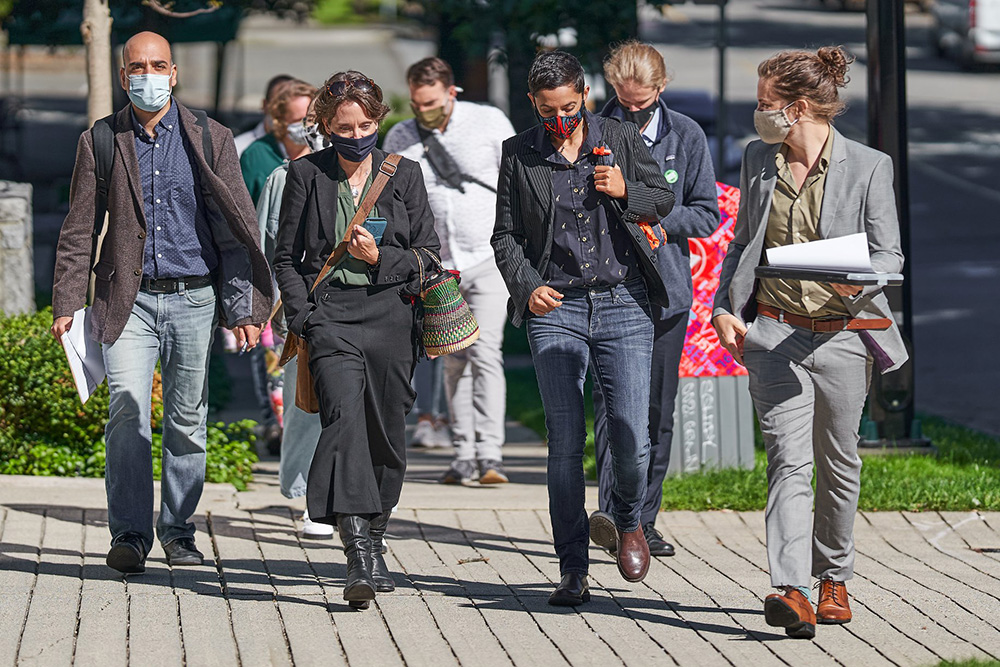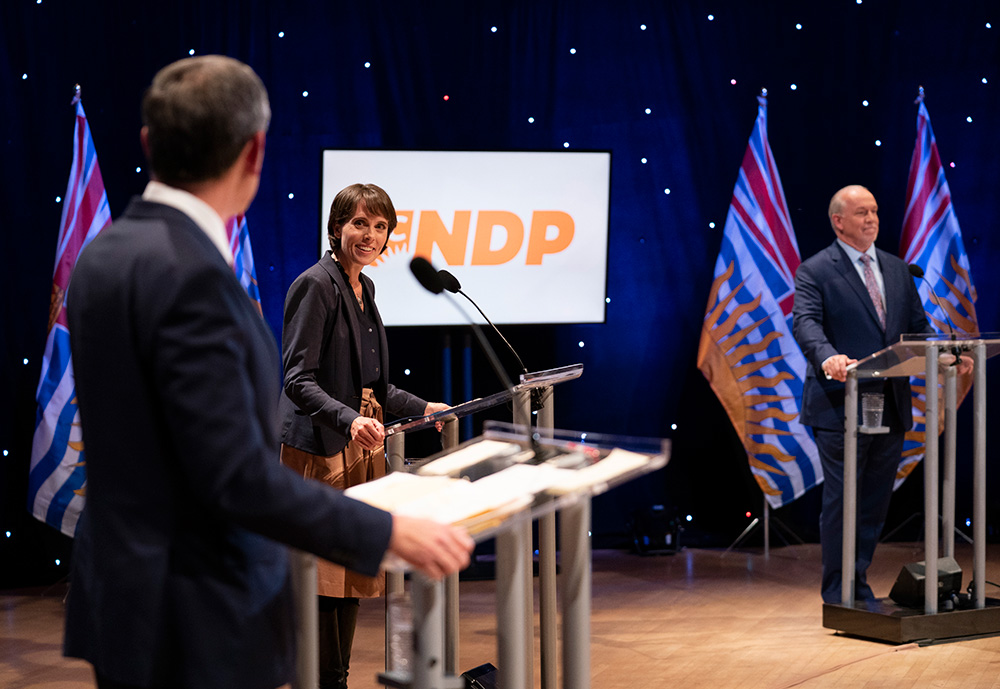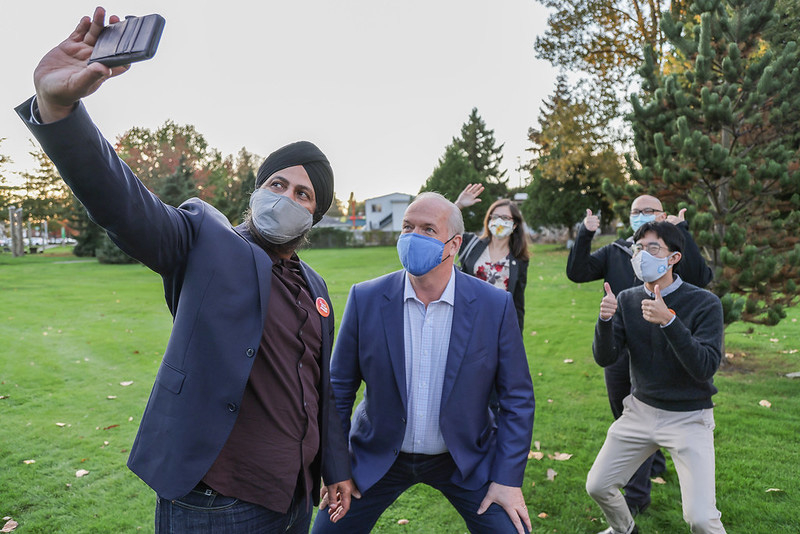It was an election like no other, in more ways than one: a snap vote called a year ahead of schedule in the middle of a global pandemic.
The gamble paid off for the New Democrats, with British Columbians electing a majority government with the first ever two-term NDP premier in John Horgan.
But the unique circumstances meant B.C.’s parties had to run radically different campaigns in this election.
Bustling party headquarters, packed rallies, leaders’ tours and smiling canvassers on doorsteps all became impossible, or at least very difficult, under provincial pandemic health guidelines.
The parties struggled to connect with older voters who are usually easier to reach, given their vulnerability to the coronavirus. And it was even harder to reach younger voters, many of them renters in high-rises or condos.
For Richard Johnston, most striking was how much the regular rhythm of campaigning changed. Johnston recently retired as Canada Research Chair in public opinion, elections and representation at the department of political science at the University of British Columbia.
Campaigns traditionally build toward an election day crescendo, he said. Leaders tour in swing ridings and parties spend more on advertising in those areas. Volunteers increase their door-knocking all the way until election day.
“As you get towards the end of the campaign, you will increasingly focus your energy, your time and, to the extent that this is possible, your money on the parts of the province where the closely fought seats are located,” Johnston said.
But with COVID-19 constraints, that regular rhythm was gone, he said. Mail-in ballots were at an all-time high and about 1.2 million votes were cast before election day.
“That’s a big change, which I’m not sure how the parties have adapted to,” said Johnston.
Campaigners from the NDP and the Greens say their campaigns had to become more decentralized, with local riding associations playing a much bigger role.
They had to find new ways to reach voters, pump up volunteers and maintain momentum. And they had to rely on a whole range of tools to do so. (The BC Liberal Party did not respond to requests for an interview. Party executive director and co-campaign manager Emile Scheffel announced his resignation Monday.)
Heather Stoutenburg, acting provincial director for the BC NDP, was the deputy digital director in the 2017 campaign. “It’s really interesting, because it was a campaign where everything was different, but simultaneously, there were so many fundamentals that are still the same.”
Evan Pivnick, a senior campaign adviser for the BC Greens and one of three leading the party’s campaign this year, noted the NDP’s early election call probably affected the campaigns as much as COVID-19 did, especially when it came to preparation.
The Greens’ leadership campaign ended just seven days before the election was called, with Sonia Furstenau emerging as the winner. The party had to secure candidates, submit paperwork to Elections BC and set up communications for the campaign — usually a months-long process — within days, he said.
“If there was a COVID election a year from now, it might be a little bit different than one where all parties are scrambling to pull together a whole bunch of different things,” he said.

The campaign bubble is real
BC NDP headquarters created its own pandemic bubble, said Stoutenburg, with everyone only going from home to work. No volunteers were allowed in the office, which hurt cross-team collaboration, she said.
And the isolation meant staff didn’t get much informal daily feedback on how the campaign was going, she said. That made it harder to keep a finger on what voters in a community were saying and feeling.
Stoutenburg recalls a round of focus groups where some party ads they were testing fell completely flat. It made her team realize how insulated they were from what British Columbians were thinking about, she said.
“It’s really important that we are able to have those conversations and those interaction points, because otherwise we’re a bunch of politicos squirrelled away in a building,” she said. “That’s not the best.”
The party maintained an active phone bank to call voters and conducted focus groups to stay fresh.
“[We tried] to get our message in front of real humans, because we definitely live in a bubble, and more so this time, when we’re in an actual bubble,” she said with a laugh.
Only a few people worked out of the BC Greens office through the campaign, said Pivnick. The leader’s tour team had less than six people, with around three regularly travelling.
Many volunteers never met over the course of the campaign, he said, given how much of it was based from home.
The first televised leaders’ debate was one of few chances that parties had to introduce their leader to most voters, so a lot of energy was spent preparing for it.
Stoutenburg wasn’t in the NDP leader’s tour bubble but witnessed the debate prep from afar.
“They kind of did the same things they normally do, which is they had plenty of mock debates. And the leader had a chance to practice a ton,” she said.

For the Greens, the debate offered an opportunity to introduce Furstenau to voters.
The party set up cameras and practised the debate over Zoom, trying to get Furstenau comfortable with the format, talking about their approach and making the setting as authentic as possible.
“Definitely the first time I’d ever done a debate prep with someone where more than half the people involved are not in the room,” said Pivnick.
To canvass or not to canvass
You can’t replace good old human connection in an election. Conventional wisdom shows that well-trained canvassers are still the most effective way to engage voters.
“There’s some notion that if you can get to a doorstep, you should try,” said Johnston. “Because it’s pretty clear that in terms of having an impact on the margin, especially of an impact of getting someone to go to the polls, there is no substitute for face to face.”
The Greens wanted to get on doorsteps as safely as possible and put together a COVID-19 canvassing guide for the campaign, Pivnick said.
Canvassers wore PPE like masks and stepped back from doors after knocking, keeping a physical distance of at least six feet. If they needed to hand something to a potential voter, they put it in their mailbox or wore gloves. Canvassers had to continuously assess whether voters were comfortable speaking to them or taking materials.
There were other opportunities to make face-to-face contact with voters, like canvassing on busy streets and at outdoor events like farmers markets and fairs.
Pivnick said the Greens didn’t get complaints from voters at the doorstep, but it was tricky finding volunteers who were comfortable about door-knocking.
The New Democrats decided not to canvas this year, a self-imposed restriction.
“Dr. Bonnie Henry said it was still safe to canvass, but we actually had made the decision from day one that we weren’t going to do that,” Stoutenburg said. “We just decided that the risk was absolutely not worth it.”
Without regular face-to-face interaction, the party relied on text messaging. “Texting definitely played a big part of our strategy. And it did in the last campaign as well, but this time, even more so.”
And direct mail — “a plain old letter in an envelope” — had “a bit of a retro moment” this election, Stoutenburg said.
Ultimately, parties reached voters through a mix of channels like TV, radio, Facebook, YouTube, Google advertising and banner ads on local websites. They spent a lot on digital advertising — from July 23 to Oct. 20, the Liberals spent $532,000 on Facebook ads alone, while the NDP spent $332,000 and the Greens $45,000, according to the Capital Daily.
Asking for money
This was the first election held under 2017’s Election Amendment Act, which banned political donations from corporations and unions and aimed to curb the power of big money in politics.
So the parties had to find ways to entice larger numbers of people to give small amounts of money. Overall, there was a lot less money in this election, Johnston said.
Without in-person fundraising at places like town halls, office openings, visits to local ridings and rallies — all opportunities for a leader to make a pitch — parties were even more constrained.
“We sort of joke that whenever you have more than five New Democrats, you know, in a space... it’s an opportunity to do a pitch and ask for money,” said Stoutenburg, who said her regular job is about 50-per-cent fundraising.
“And so when we don’t have five, more than five New Democrats, in any space ever... it very much changed our fundraising strategy, for sure.”
Pivnick agreed that not being able to gather crowds posed a challenge, and fundraising was mainly conducted through digital, email, phone calls and direct mail.
The campaign of the future
Johnston believes that with the simplicity of mail voting and the trust voters have in Elections BC, “the order of magnitude of mail voting has gone up irreversibly.”
“Some people may back off, or some people may decide to go to advanced polls or to election day polls in the future, because there’s no longer the fear of the virus. But the convenience is huge,” said Johnston. “And I think a lot of people are going to opt for that convenience.”
He wonders how more early voting could affect the future rhythm of campaigns. “If people are going to start casting ballots, in quite large numbers, virtually from the start of the campaign, then what?”
One online campaign event has a promising future — the online town hall.
Stoutenburg said it was beneficial for candidates and voters from across the province to be able to drop into an event and hear from the NDP leader and ask him questions.
More than 1,000 people watched one such event live, and thousands more saw it in their social media feeds afterwards, she said.
“I think in terms of the leader being able to drop into a campaign, somewhere he might not normally be able to visit, we’re probably going to continue with that,” she said.
But despite all the talk of the access and convenience, it’s hard to shake off the fact that turnout might end up being the lowest in nearly a century.
That concerns Pivnick. “It can be dangerous to take too much away when we’re missing 10 to 15 per cent of people who voted last time, based on current numbers,” he said.
Pivnick said future campaigns will look similar to 2020’s, with the exception of this year’s online rallies. “I don’t think Zoom rallies will be a thing as soon as people can be back in groups,” he said.
He said the bar to entry when it comes to voting will be lowered in future, noting recent changes to B.C.’s Election Act that allow pre-registration of 16- and 17-year-olds before they turn 18.
“I think what’s going to stick around is we’re going to have our voting systems have an even greater degree of resiliency built into them for all sorts of different types of events, to ensure that people can vote and vote in different ways and vote at different times.”
Pivnick said evidence is mounting about the importance of connection. Even with modern campaign tools, human campaigning — one person talking to friends on social media — is becoming more and more effective.
“The one thing that is going to sort of rebound back on the other side, more than anything else, is a desire to actually need to discuss, engage, you know, as authentically human to human as we can,” Pivnick said. ![]()
Read more: BC Election 2020
















Tyee Commenting Guidelines
Comments that violate guidelines risk being deleted, and violations may result in a temporary or permanent user ban. Maintain the spirit of good conversation to stay in the discussion.
*Please note The Tyee is not a forum for spreading misinformation about COVID-19, denying its existence or minimizing its risk to public health.
Do:
Do not: